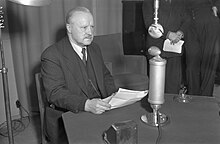Moscow Peace Treaty
This article needs additional citations for verification. (March 2009) |
USSR | |
| Parties | |
|---|---|
| Ratifiers | |
The Moscow Peace Treaty was signed by Finland and the Soviet Union on 12 March 1940, and the ratifications were exchanged on 21 March.[1] It marked the end of the 105-day Winter War, upon which Finland ceded border areas to the Soviet Union. The treaty was signed by Vyacheslav Molotov, Andrei Zhdanov and Aleksandr Vasilevsky for the Soviet Union, and Risto Ryti, Juho Kusti Paasikivi, Rudolf Walden and Väinö Voionmaa for Finland. The terms of the treaty were not reversed after the dissolution of the Soviet Union. The Karelian question refers to the debate within Finland over the possible reacquisition of this ceded territory.
Background
The
Finland rejected the demands and intensified its pleas to Sweden, France and the United Kingdom for military support by regular troops. The reports from the front still held out hope for Finland, anticipating a League of Nations intervention. Positive signals, however inconstant, from France and Britain and more realistic expectations of troops from Sweden, for which plans and preparations had been made throughout the 1930s, were further reasons for Finland not to rush into peace negotiations. (See Winter War § Foreign support for more details.)
In February 1940, Finland's commander-in-chief, Marshal Carl Gustaf Emil Mannerheim expressed his pessimism about the military situation, which prompted the government to start peace talks on 29 February, the same day the Red Army started an attack on Viipuri (now Vyborg).
Terms

On 6 March, a Finnish delegation, led by
The treaty was signed on the evening of 12 March, Moscow Time, or 1 hour on 13 March, Finnish time. The protocol appended to the treaty stipulated that the fighting should end at noon, Leningrad time (11:00 Finnish time),[inconsistent][6] and the fighting continued until then.[7]
Finland ceded approximately half of
There was also an area that the Russians captured during the war that remained in Finnish hands according to the treaty: Petsamo. The treaty also stipulated that Finland would grant free passage for Soviet civilians through Petsamo to Norway.
Finland also had to cede a part of the
Contrary to a common belief, the Soviet troops' transfer rights by railway to the Hanko base were not granted in the peace treaty, but they were demanded on 9 July, after Sweden had acknowledged the railway transit of Wehrmacht troops to occupied Norway.
Additional demands were the handing over any equipment and installations on the territories that were ceded. Thus Finland had to hand over 75
Aftermath
The harsh terms imposed on the Finns led them to seek support from Nazi Germany.[citation needed] The Winter War and the subsequent peace treaty were core factors in leading to what would become the Continuation War, when hostilities resumed in 1941.
See also
- Treaty of Tartu
- Interim Peace
- Moscow Armistice
References
- The American Journal of International Law34 (3), Supplement: Official Documents. (July 1940), pp.127–131.
- ISBN 1-85410-881-6.
- ISBN 978-952-373-053-3.
- ^ Pietinen Otso, kuvaaja. ulkoministeri Väinö Tanner Yleisradiossa ja talvisodan rauhanehdot. Retrieved 31 December 2019.
- ISBN 1-85065-421-2.
- ^ "Protocol appended to the treaty of peace concluded between Finland and the Union of Soviet Socialist Republics on 12 March 1940".
- ^ Степаков, Виктор, Евгений Балашов. В «Новых районах»: Из истории освоения карельского перешейка, 1940–1941, 1944–1950 Archived 2 December 2007 at the Wayback Machine. Saint Petersburg: Нордмедиздат, 2001. p. 5
- ^ Statistics Finland (1941). Suomenmaan Tilastollinen Vuosikirja 1940 [Finnish Statistics Yearbook 1940] (PDF) (in Finnish). pp. 14–15.
